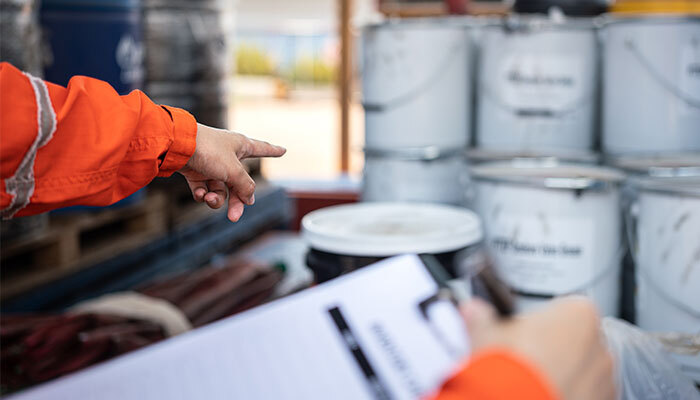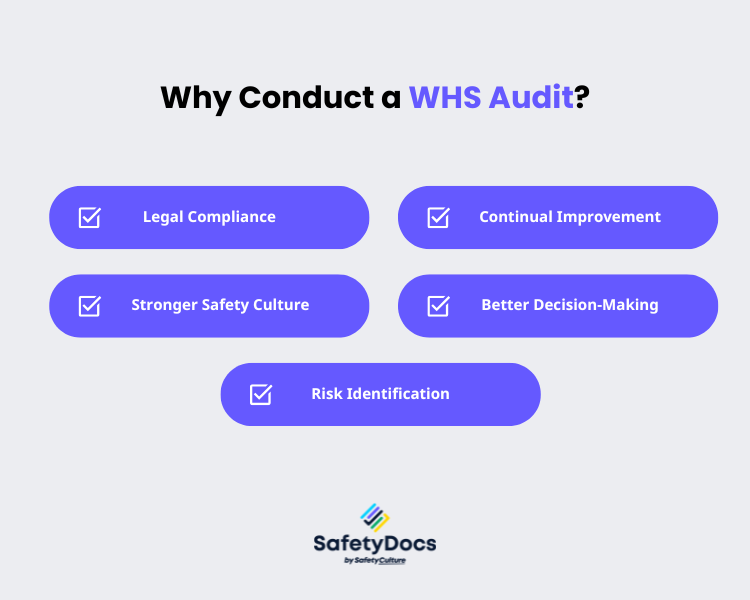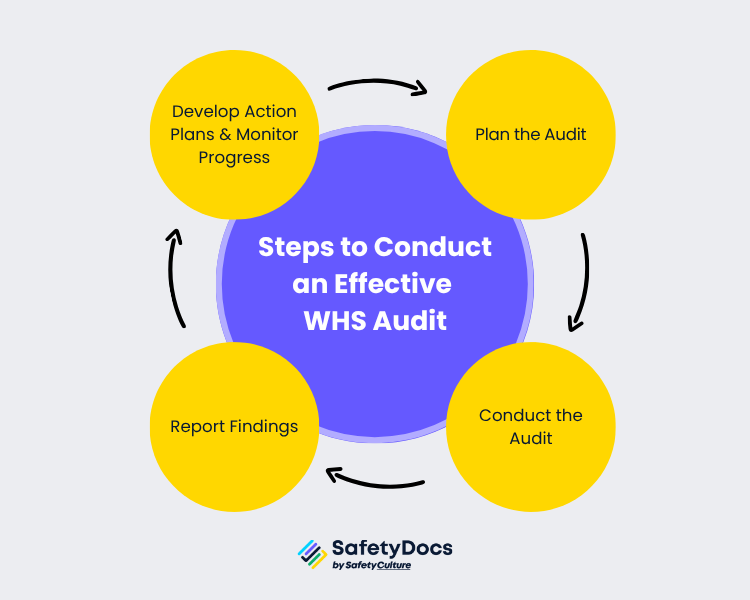A WHS (Work Health and Safety) audit is a powerful process for organisations to maintain safety, ensure compliance with WHS legislation, and proactively reduce workplace risks. But without a structured approach, WHS audits can become time-consuming and ineffective.
This guide breaks down the steps to conduct a WHS audit, from planning and execution to reporting and follow-up. Whether you're a safety officer, compliance manager, or business owner, a well-run WHS audit supports continuous safety improvement and a positive workplace safety culture.
What is a WHS Audit?
A Work Health and Safety (WHS) audit is a structured and methodical review of an organisation’s safety systems, policies, and procedures. Its purpose is to assess whether the business is complying with its legal obligations under WHS laws and to evaluate how effectively it is managing health and safety risks in the workplace.
Rather than simply being a compliance checkbox, a WHS audit serves as a powerful way for businesses to improve the overall performance of a WHS Management System (WHSMS). It identifies areas of strength and highlights gaps or weaknesses that may lead to safety failures if left unaddressed.
Whether a WHS audit is conducted internally or by an external auditor, the process provides valuable insights that support continual improvement, risk reduction, and a stronger safety culture.

Why Conduct a WHS Audit?
A well-planned and executed WHS audit can be beneficial, particularly for organisations committed to implementing proactive safety management. Here’s how:
Legal Compliance
Audits help businesses stay compliant with WHS legislation, relevant codes of practice, and Australian standards. By identifying areas where procedures fall short, organisations can take timely corrective action and avoid potential penalties, fines, or prosecution.
Risk Identification
Through inspections, interviews, and document reviews, WHS audits uncover hazards, assess existing controls, and identify potential risks that might otherwise go unnoticed. This early detection is critical in preventing incidents, injuries, and costly disruptions.
Continual Improvement
Audits support the continual improvement of your safety systems by providing a clear snapshot of how well your WHSMS is working. Audit findings offer actionable recommendations to refine processes, close compliance gaps, and drive better outcomes over time.
Stronger Safety Culture
When audits are integrated into regular business practices, they promote accountability, transparency, and a shared commitment to safety. Involving workers in the process also encourages engagement and reinforces the idea that occupational health and safety is a priority at every level of the organisation.
Better Decision-Making
Audit reports provide objective data that can guide leadership decisions on resource allocation, training needs, or policy updates. This ensures safety improvements are informed, strategic, and aligned with business goals.
A safety compliance audit doesn’t just help you meet regulatory obligations; it plays a key role in shaping safer, smarter workplaces. Done well, it can reduce incidents, support continuous learning, and help your team embed safety into the everyday.

Types of WHS Audits
There’s no one-size-fits-all approach to WHS auditing. The type of audit your business needs will depend on a range of factors: who is conducting the audit, what the focus is, and the specific compliance or certification outcomes you're aiming for.
Broadly speaking, WHS audits can be grouped into two key dimensions: who conducts the audit (internal vs external) and what is the focus of the audit (compliance vs operational performance). Understanding these distinctions helps you plan a more targeted and effective auditing strategy.
Internal WHS Audits
As the name suggests, internal audits are conducted by people within your organisation, typically WHS staff, trained workers, or team leaders with auditing responsibilities. These audits are an essential part of an organisation’s internal assurance and risk management framework.
The goal is to evaluate how well internal processes align with your WHSMS, WHS policies, procedures, and legislative obligations. More importantly, internal audits help identify strengths, weaknesses, and opportunities for continual safety improvement.
Internal audits may include:
- System audits to evaluate the overall WHS Management System
- Compliance audits against internal or legal standards
- Process audits focusing on specific work activities
- Documentation reviews to verify that safety records are up to date and accurate
Conducting regular internal audits demonstrates a proactive safety culture and helps organisations address issues early, before they result in serious incidents or regulatory action.
External WHS Audits
An external audit is carried out by a third party. This type of WHS audit is done by independent assessors to meet external obligations, such as industry certifications, client requirements, or regulatory approvals.
External audits provide an objective evaluation of your WHSMS and your business’s compliance with recognised WHS legislation, standards, and codes of practice.
They are commonly required for:
- Certification schemes (e.g., ISO 45001, AS/NZS 4801)
- Client contracts with strict safety expectations
- Licensing for high-risk activities or industries
- Self-insurer status audits for workers' compensation
Because of the independence and rigour of external WHS audits, they can be seen as more credible by external stakeholders. External audits can also provide fresh insights and identify blind spots that may be overlooked internally.
Compliance vs Operational WHS Audits
Compliance Audits
A safety compliance audit assesses whether your organisation is meeting its legal obligations under WHS legislation, codes of practice, and Australian Standards. These audits are typically evidence-based, focusing on whether required documents, records, and systems are in place and being maintained.
They answer the question: Are we legally compliant with the current WHS requirements?
Compliance audits are especially important in regulated industries or where businesses are preparing for official inspections or certifications.
Operational Audits (also known as System Audits)
Operational WHS audits go beyond checking for compliance. These audits examine how effectively the WHS Management System is being implemented in day-to-day operations and whether it’s truly reducing risk and improving safety outcomes.
This type of WHS audit may look at:
- Whether safety procedures are followed on site
- How well risk controls are working in practice
- Staff awareness and understanding of their own WHS responsibilities
- Integration of safety into broader business processes
Operational audits are valuable for driving performance improvement and not just for proving compliance.
Other Types of WHS Audits
In addition to the core audit types, some businesses may use more targeted audits to assess specific areas of concern or to meet unique requirements:
- Desktop audits - Focused on reviewing WHS documentation, such as policies, risk registers, and training records.
- Gap analysis audits - Compare existing practices against standards to identify where improvements are needed.
- WHS Management Plan audits - Evaluate the suitability and implementation of site-specific WHS management plans.
- Industry-specific audits - Such as those required by the Federal Safety Commissioner (FSC) or sector-specific compliance frameworks.
- Self-insurer audits - For businesses applying for or maintaining self-insurer status under workers’ compensation schemes.
Choosing the Right Mix
There’s no single "best" audit type; it depends on the needs of your business, compliance risks, and operational complexity. Many organisations benefit from using a mix of internal and external audits, as well as alternating between compliance-focused and operational reviews to get a more complete picture of their WHS performance.
Regular, well-structured audits are an investment in continuous improvement and safer workplaces, and they’re much easier to manage with the right systems and templates in place.
Steps to Conduct an Effective WHS Audit
It is important to remember that a WHS audit isn’t just about ticking boxes; it’s about taking a structured, proactive approach to managing risks and improving performance over time. When done well, an audit can uncover hidden hazards, highlight gaps in compliance, and drive meaningful change across your organisation. And to achieve these outcomes, the process needs to be clear, consistent, and well-executed from start to finish.
Below is a step-by-step guide to help you conduct a thorough and effective WHS audit, from initial planning right through to actioning improvements and monitoring results.
1. Plan the Audit
Start with clear objectives. Define the following:
- Scope: What areas, processes, or sites will be audited?
- Schedule: Set audit timelines and notify key stakeholders.
- Resources: Assign roles and responsibilities.
- WHS checklist: Choose or customise your checklist to ensure consistency and coverage.
Explore ready-to-use Audit Checklists to streamline the planning phase.
2. Conduct the Audit
This phase involves collecting data and evidence. Key activities include:
- Site inspections: Walkthroughs to observe hazards and safety controls.
- Interviews: Speak with staff to understand safety practices and uncover gaps.
- Document review: Examine training records, incident logs, maintenance schedules, and policy documents.
Use an internal safety audit template to stay organised and consistent.
3. Report Findings
Compile the data into a clear and practical report that includes:
- Findings: Identify compliance and non-compliance.
- Evidence: Support each finding with observations, photos, or documentation.
- Recommendations: Offer actionable steps for improvement.
Reports should be easy to understand for both management and workers.
4. Develop Action Plans and Monitor Progress
An audit is only valuable if findings lead to real safety improvement. Turn your recommendations into action by:
- Assigning tasks and deadlines.
- Tracking implementation progress.
- Re-auditing where needed to ensure follow-through.
Make sure your safety system is equipped to manage corrective actions and track changes over time.
SafetyDocs’ Safety Management Systems include all the tools you need to close the loop after following the steps to conduct a WHS audit.

Common Risks and How to Avoid Them
Even with the best intentions, WHS audits can fall short if not executed properly. Understanding the common risks can help you stay on track and ensure your audit process delivers real value. Here are some of the most frequent issues organisations face, and what you can do to address them.
1. Lack of Preparation
Jumping into a WHS audit without a clear plan often leads to confusion, delays, and missed opportunities. Without defined scope, checklists, and timelines, auditors may waste time on irrelevant areas or overlook critical hazards.
What you can do: Take the time to plan your audit thoroughly. Define what you’re auditing, what tools or templates will be used, and who is going to be involved in the audit. A structured WHS checklist ensures consistency and completeness across different audit teams and worksites.
2. Biased or Inexperienced Auditing
Internal safety audits conducted by staff without proper training or by internal auditors with close involvement in the areas being audited can lack objectivity. This can result in serious risks being downplayed or missed entirely.
What you can do: Provide workplace health and safety audit training for internal staff and, where possible, assign auditors who are independent of the area being assessed. Consider engaging third-party experts (external auditors) for high-stakes or certification-related audits to ensure impartiality.
3. Overlooking Worker Input
Frontline workers are often the first to notice unsafe practices or gaps between policy and reality. Yet, audits that focus only on paperwork or management input can miss these valuable insights.
What you can do: Include staff interviews or informal conversations as part of your audit process. Workers’ firsthand experience can highlight hidden risks and offer practical solutions that improve both safety and compliance.
4. Not Following Up on Findings
One of the biggest mistakes businesses make is treating the audit report as the end of the process. Without follow-up, even the most thorough audit won’t lead to actual safety improvements.
What you can do: Develop clear action plans for each finding, assign responsibilities, and set deadlines. Use your safety management system to track progress and ensure corrective actions are implemented and reviewed.
By planning ahead, involving the right people, and acting on your findings, your audit can become a powerful driver of continual safety improvement, not just a box-ticking exercise.
If you're unsure where to begin or want a structured approach, a comprehensive WHS internal audit guide can help you follow best practices and avoid common mistakes
Tools For Your Effective WHS Audit Process
SafetyDocs by SafetyCulture makes it easier than ever to manage your audits from start to finish. Whether you're new to auditing or fine-tuning a mature WHS program, our solutions help ensure consistency, accuracy, and compliance.
- Audit Checklists - Choose from a library of customisable checklists.
- Safety Management Systems - Get a complete framework for managing audit outcomes, risk controls, and corrective actions.
These tools are designed to save time, reduce errors, and support your ongoing safety improvement across all business sizes and industries.
How SafetyDocs Can Help Build a Safer Workplace
Regular WHS audits are more than a compliance requirement; they’re an investment in a safer, more efficient, and more resilient workplace. A proactive approach allows you to detect issues early, involve your workforce in safety decisions, and continually improve systems and culture.
With the right tools, planning, and commitment, your business can make workplace safety audits a cornerstone of success.
Our team of experts is dedicated to providing accurate and informative content. Craig Cruickshank, our senior HSEQ advisor at SafetyDocs by SafetyCulture has reviewed this blog post to ensure the highest level of quality.
Learn more about Craig's work on LinkedIn for more industry insights.
Available for instant download and supplied in fully editable MS Word format for use in your business.
Please note that the above information is provided as a comment only and should not be relied on as professional, legal or financial advice.
Share This Article
